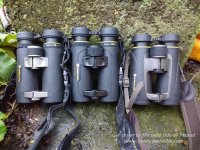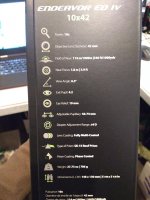I've had a pair of 10x42 Endeavor EDIV for review on the Ireland's Wildlife site since October, and whatever the foibles reported here with initial samples, it looks like Vanguard got a lot right with the production model.
The ergonomics are superb and optically they're a definite step up from the already impressive EDII. Bright, sharp image right across a pleasingly wide and immersive field of view. Very good low light performance... which must be down to the new SK15 prisms, because I asked about dielectric coatings and the head of Vanguard UK stated categorically that there are " No dielectric coatings on any of our prism systems… yet".
They do perform very well in low light -- and although they fall short of my 10x42 Swaros in terms of brightness as the light fades, they continue to deliver plenty of detail and good colour and contrast. The focus is a bit stiffer than it's predecessors, but not uncomfortably so, and for me the 1.5 turn focusing mechanism is an improvement. I found it easy to overshoot focus with both the ED and EDII -- not so with the EDIV.
Everything just feels like an improvement. It feels as if Vanguard has been listening to its end users / reviewers here, making lots of little changes. Seemingly insignificant things... like losing the clip system on the neckstrap (does any birder really use those?), so that now you can actually shorten the strap so the bins sit on your chest, not around your waist... and adding hydrophobic coatings on the external lens surfaces... add up to deliver a much more satisfying all-round user experience.
I'm still not about to trade my Swaros in for a pair of EDIV -- but I can genuinely say that this is the first Vanguard binocular I'd seriously consider as a contender if I was in the market.
I'll be posting a full review to the Ireland's Wildlife site soon, and have a competition running until midnight on Thursday to win a brand new pair direct from Vanguard in time for Christmas.
I'm not going to post the link to the forum, but you'll be able to find it if you want to.
Cheers,
Calvin!





